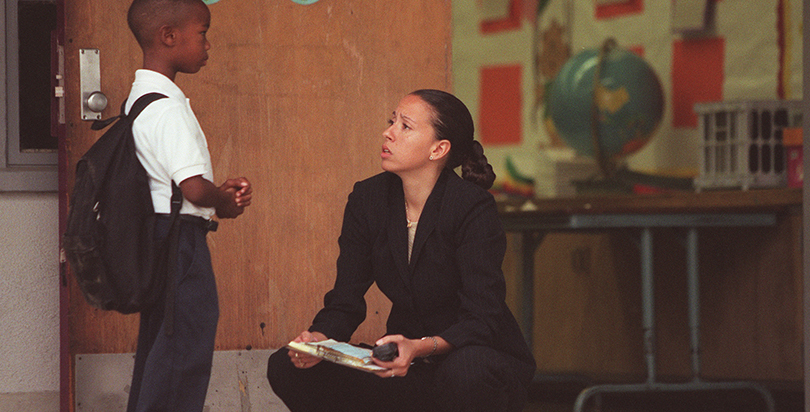74 Interview: New Leaders Co-founder Benjamin Fenton on ESSA and How to Develop Better Principals

See previous 74 interviews: Former Gov. Jeb Bush, tennis great and charter supporter Andre Agassi, and current U.S. senator and education committee chairman Lamar Alexander. Full archive here.
Not at New Leaders. The New York City–based nonprofit has been training principals to work in high-poverty schools for 15 years, and this year published its first book, Breakthrough Principals: A Step-by-Step Guide to Building Stronger Schools. Co-author Benjamin Fenton said the book — based on a RAND Corporation data analysis of New Leaders’ graduates and on visits with leaders of traditional and charter schools across the country — is an encyclopedia of policies and strategies that have guided New Leaders’ principals to success and can be replicated by other school leaders who face difficult odds.
“These folks weren’t superheroes,” said Fenton, co-founder and former chief strategy officer for New Leaders, who is now a senior adviser at Turnaround for Children. “There weren’t only a few people who magically figured out great school leadership.”
In an interview with The 74, he offered his take on what makes high-quality school leaders tick and how the Every Student Succeeds Act can revitalize the role of the principal. The conversation has been edited for space and clarity.
The 74: Why did you embark on this project?
Fenton: The impetus came from looking at the results of our first seven to eight years of principals. We had put a very specific focus on training aspiring principals for high-poverty schools, and around 2007, 2008, we were in partnership with the RAND Corporation beginning to look at the results across schools and across cities. The most important news for us as an organization is that they found statistically significant outperformance of our principals compared to similar schools. We had that top-level good news, but underneath that we could see some pretty substantial variation [among principals] … and at the same time we had an incredible opportunity, through a couple of federal grants, to identify the highest-gaining schools in a couple of cities and charter networks. Eventually, it allowed us to look at 200 schools, really go in and look at their variations and leadership practices. We even did written case studies and video case studies of them. That’s the genesis of the transformational-leadership framework in the book.
The 74: What are the main differences between the principals who got results and those who struggled?
Fenton: The ones who were successful realized they had to pick a few specific things and really work hard to change those. That’s one category. The second thing is big areas of school leadership. In our framework, we talk about learning and teaching, school culture, talent management, planning and operations. In the learning/teaching category, one thing we heard from every school we visited is that they were using data to give instructional feedback. Every week or two someone was looking at the teacher, observing their instruction and giving real feedback. On the data side, it was a real focus on frequent gathering of information on how students were doing, looking at student work. And then, teachers set up a plan for how their instruction would be different in the next day, week, quarter, based off what they were learning. In the talent management category … the strongest principals were relentless in thinking about how to get great teachers in front of students. Anytime they had an opening, they spent much more time working on recruiting and hiring. Principals who were the most successful have built strong instructional leadership teams. They saw their job as identifying and developing instructional leaders beyond themselves.
The 74: Did any of this surprise you?
Fenton: The things that were most surprising were in the talent management category, in how consistent they were. In the framework, when we drafted it, we did not have a whole category around talent management. But it was through this study that we saw how incredibly important the hiring process was.
The 74: We don’t hear much about diversity at the principal level. Do you think there is an impact on education with diverse school leaders?
Fenton: We think there is power in building a community with teachers, with students, with families, and valuing and respecting the roots of community. More than 70 percent of leaders we’ve trained have been leaders of color. We believe there was great talent that wasn’t being identified. We took it very seriously, partly to help our success but also for schools searching for strong teachers who have had results with students who will be ready to be leaders for others.
The 74: How do you think New Leaders differs from other principal development programs?
Fenton: When we began in 2001, the big change we brought was much stronger front-end thinking about who should come into principal development programs. To do this kind of instructional leadership, you have to be very strong and knowledgeable about instruction yourself be able to observe and handle teachers successfully. [Aspiring principals must also possess] beliefs that every child, regardless of background, could be successful, that you could share that belief, that sense of possibility, with other adults and build that as a culture…. and, most importantly, want to move from the great work of working directly with children to working on behalf of children, but with other adults.
The 74: How is principal training different in 2016 than when you started in 2001?
Fenton: Larger districts have thought about how important school leadership is to their success. They are doing much more to select folks who have this kind of instructional expertise. I will say this: There is a long way to go for a lot of principal development organizations across the country. I think many education administrator programs are still trying to balance folks who are working to get to the next level of master’s degree or experience but may or may not be pushing to that principal role.
The 74: How might the Every Student Succeeds Act change the role of the principal?
Fenton: There are a couple things we’re excited about in ESSA. One is, we have more focus on school leadership throughout the law. Ninety-seven percent of teachers in surveys say the quality of the school leadership is essential or very important for retention, and that’s well ahead of any other factor. In most states or districts, when they think about teacher learning or teacher quality for school success, they are not thinking about school leadership as a major investment. Under No Child Left Behind, there wasn’t much focus on principals as a key lever. So we’re excited that under ESSA, there are a number of things that really highlight that priority. There is language that makes clear the importance of school leaders that’s separate from teachers. There is a new optional set-aside at the state level for Title II money toward building quality school leaders across the state, and in many of the grant programs within Title II, there are focus areas for school leadership.
The 74: States have more flexibility in how they assess schools under ESSA. How will that affect principals?
Fenton: One of our hopes is that ESSA gives more flexibility to think about targeting more closely to the specific needs of the schools, that school leaders will have more of a role in what those plans are, and that there is a more balanced sense that you’ve got real accountability as a leader to show improvement, but also that they’re not going to take away your decision-making rights if you are in that improvement place. Any state plan needs to have a significant piece around ensuring the quality of leadership at schools that need improvement, something like what Connecticut has done, making a real investment in supporting turnaround school leaders.
The 74: Let’s talk about some of the principals in the book. Claudia Aguirre, who ran a dual-language middle school, says, “We only have 30 months to prepare our students for high school.” Why was she effective?
Fenton: Many of the kids had not had the kind of literacy development we would have hoped in their K-5 experience. Many of them had been identified as English-language learners for a number of years and had a long way to go to be ready for ninth grade and high school. But she would tell her team: We take full responsibility; we have to do everything we can do to get them ready, no matter what their grade level, no matter when they came to this country; it is our responsibility to figure out what we can do in grades six through eight to get them ready. They built a huge literacy block that crossed every adult in the building. Everyone learned to do aspects of literacy development. They were able to break down the students into very small groups with the strongest teachers of English, as well as those who had a background in English-language development. I can remember sitting in her office, and there was a constant stream of leaders: an assistant principal, an instructional coach, another developer of curriculum. They were constantly in and out of her office asking a quick question, getting students’ files, sharing what they were doing. These other leaders were working one-on-one with teachers in the building. They were videotaping teachers, sitting with them. She had not only a deep set of beliefs, but structurally, she had all these systems for developing her teachers and supporting them in their work.
The 74: Can you tell us why David O’Hara’s approach in Brooklyn was successful?
Fenton: He came into a high school that had very low graduation and college-going rates, and he and his team made a real dedication to change that set of beliefs and work with students all the time about what it takes to be ready for college in terms of academic readiness and application readiness. Each spring, when people come together to share their college acceptances, it’s a very public, very visible event. It builds a certain awareness in the community about how important that is and what it means to be ready for that. I think he would say, as much as you can work on that culture, you have to in parallel do the really hard academic work. They built a whole set of performance tasks and assessments [to measure] what students are going to have to do [to be] college-ready. There was lots of agreement from teachers about what that looks like.
The 74: Is there anything else to take away from this work?
Fenton: These folks weren’t superheroes. There weren’t only a few people who magically figured out great school leadership. There are a lot of folks we were able to profile, and we were quite surprised at how consistent their practices were and how they developed in schools in these stages. This book gives folks a sense of what that journey is. Where do you begin? What can you focus on first? We found that many leaders have been able to put into practice [the framework] and to bring their own personality, style and approach to it.
Get stories like these delivered straight to your inbox. Sign up for The 74 Newsletter

;)
